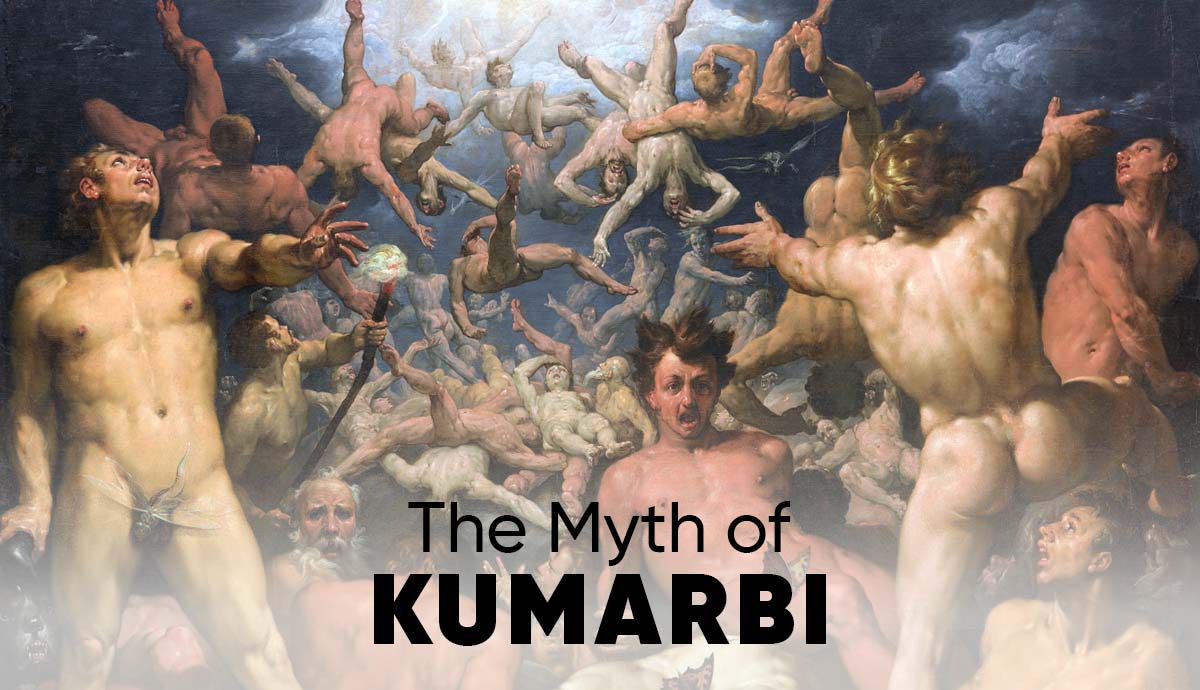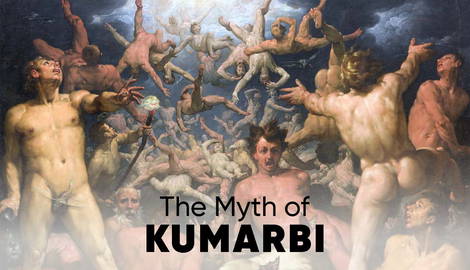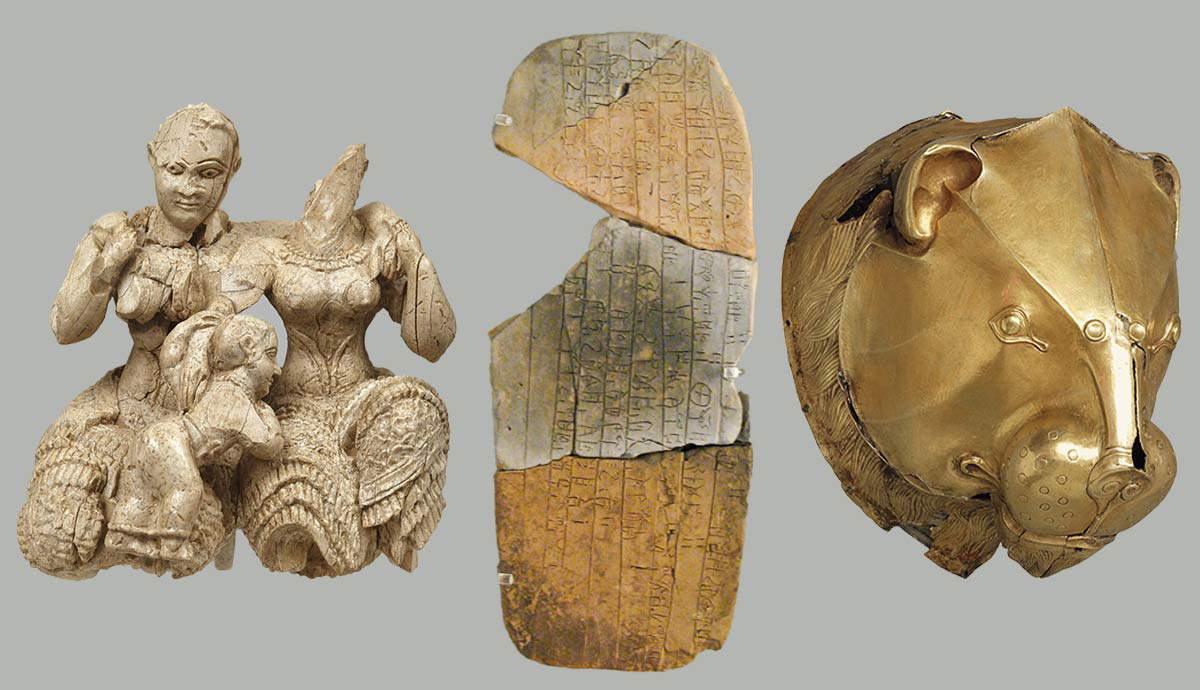
The Kumarbi Cycle was a Hurrian myth adapted by the Hittites. While Kumarbi himself was a Hurrian god, the epic incorporates other gods from Near Eastern cultures, like the Babylonians and Syrians. The storm god, called Teshub in Hurrian, was replaced with the Hittite and Luwian god Tarhun. His sister, Shawushka, was replaced with Anzili. The Kumarbi Cycle describes the birth of gods and the struggle for succession for the rule of heaven. This theme of divine succession would later be appropriated by the Greeks, as seen in Hesiod’s Theogony.
The Kumarbi Texts

The surviving copy of the Kumarbi Cycle is separated into many parts, three of which are still preserved. The tablets found were written in Hittite between 1400 BCE and 1200 BCE. The story was probably originally recorded during the height of Hurrian civilization around 1500 BCE.
The Hurrians lived in northern Mesopotamia during the Bronze Age and spoke a language that was not related to that of their neighbors. By the late Bronze Age, they were largely assimilated into the surrounding cultures, but they also left their own cultural impact, especially on the Hittites, who established a great empire in the Near East between roughly 1600 and 1200 BCE.

The first part of the Kumarbi Cycle was the Song of Birth or the Song of Coming Forth, previously known as the Song of Kingship in Heaven or the Song of Kumarbi before scholars learned the true title. This part detailed the rise to power of Kumarbi and the birth of the Storm God, Tarhun, and his generation of gods.
The following part was the Song of the Sea, which no longer survives but was summarized in another text. This song describes Tarhun’s battles against the Sea. The Song of LAMMA, which is very fragmentary, describes the rule of a tutelary god whose name is represented by the Sumerian sign LAMMA. This god somehow defeated Tarhun and was king of heaven for a time before ultimately being deposed.
The Song of Silver describes the birth of Silver, another son of Kumarbi, who was king in heaven for a time as well. The next two parts, called the Song of Hedammu and the Song of Ullikummi, describe the battles between Kumarbi and Tarhun as Kumarbi tries to regain the throne of heaven from the Storm God by birthing new sons to rival him.
Song of Birth

Only the first tablet from this multi-tablet poem survives. The myth opens with a call to the Former Gods to listen to the story of the birth of the Storm God. It starts with Alalu, the king in heaven, who ruled in heaven for nine years before being overthrown by his cup-bearer, Anu, and fleeing into the underworld. After another nine years, Anu was overthrown by his cup-bearer, Kumarbi. Anu tried to flee into the sky, but Kumarbi caught him by the foot and pulled him back down. He bit Anu, castrating him with his teeth, then swallowed his genitals.
Kumarbi celebrated his victory, but Anu told him that he was now pregnant with three of his children before fleeing into heaven. Kumarbi spat out the genitals onto Mount Tassa, which gave birth to Tashimushu, but Kumarbi was still pregnant with two gods. Kumarbi went to the city of Nippur, where he tried to determine the best way to give birth. He, Anu, and the yet-to-be-born Tarhun discussed the options and considered that Tarhun be born from Kumarbi’s head. After Tarhun was born, the fate goddesses sewed up Kumarbi’s skull.
Upset at the birth of a rival for the throne, Kumarbi demanded that Ea, a god of wisdom, give him the newborn Tarhun. But Ea tricked him and gave him a basalt stone. When Kumarbi tried to eat it, he broke his teeth on the stone and threw it away. A cult formed around the discarded stone. Tarhun, having now grown into an adult, spoke to a different deity, Sherish, about defeating the other gods and taking control of heaven. Sherish told Ea of Tarhun’s plan, and Ea became furious. The text becomes incredibly fragmented by the end of the tablet, so the events are unclear, but what is clear is that Kumarbi had two new godly sons.
Song of Hedammu

The Song of Hedammu survives in many fragments, and the beginning of the story is not known, but the general plot can be gleaned from what remains. Kumarbi determined that in order to maintain his prestige, he needed to conceive a child to rival Tarhun. He proposed a marriage to the daughter of the Sea, named Shertapshuruhi. Their son, Hedammu, was raised in secret so as not to alert Tarhun or his sister, Anzili, the Hurrian equivalent of the Mesopotamian goddess Ishtar.
Hedammu had a ravenous appetite, eating thousands upon thousands of all animals imaginable, so many that it was beyond count. Somehow, Anzili heard about the monstrous Hedammu, and she went to warn Tarhun about the danger. The Storm God then visited Kumarbi to ask about this new rival.
At some point, Ea tried to impress upon the two warring gods the consequences their struggle was having on humans. He complained that humans would no longer give sacrifices or worship the gods if their conflict continued, saying that the gods would have to till the fields or grind grain themselves. After the discovery of Hedammu, Anzili tried to seduce the monster in order to vanquish him. She presented herself naked on the edge of the sea, singing songs and striking cymbals together to get the monster’s attention. The end of the story isn’t known, but it is assumed that Tarhun and Anzili defeated Hedammu.
Song of Ullikummi

The Song of Ullikummi again begins with Kumarbi heading down to the Sea in order to give birth to another child that will rival Tarhun. This child was born from a basalt stone, and Kumarbi named him Ullikummi, which translates to “destroy Kummi,” the city where Tarhun was king. Ullikummi was given to the Fate Goddesses to raise and then given to an Atlas-like god named Ubelluri. Each day, the young god grew larger, until he grew so tall that the waters of the sea reached only to his waist and he could touch the heavens. The sun god, Istanu, saw Ullikummi and went down to Tarhun to warn the Storm God.
Like in the Song of Hedammu, Anzili is called upon to seduce the basalt giant. She adorned herself in gold and burned incense. She played a lyre, struck cymbals, and sang songs to gain Ullikummi’s attention. The giant came to her, but he was immune to her seduction, telling her to go and get Tarhun. Hearing of his sister’s failure, Tarhun prepared himself for battle. The Storm God and 70 other gods battled against Ullikummi but were soundly defeated, and Ullikummi scattered them out of heaven.
Tarhun went to see Ea to ask for help in defeating Ullikummi, and Ea came up with an idea to use the copper saw that was used to split apart heaven and earth. With this new weapon in hand, the gods again gathered to confront Ullikummi. The battle was so destructive that the earth split open and the dead came up and walked the earth again, but Ullikummi was ultimately defeated.
Influence on Greek Mythology

The Kumarbi Cycle not only influenced Hittite and Mesopotamian mythologies but also made its way to Greece. Hesiod’s Theogony, an ancient Greek epic poem written in the 7th century BCE describing the birth of the gods, the reign of the Titans, and Zeus’ rise to power, shows clear influence from the Kumarbi Cycle.
The succession from Uranus to Cronus, then Cronus to Zeus, follows closely the successions in the Song of Birth as Anu was overthrown by Kumarbi, and then Kumarbi was overthrown by Tarhun. Both myths depict the castration of the sky, Anu and Uranus, as well as the birth from the blood and semen of the castrated sky gods. In the Greek version, the blood and semen land upon the earth to birth the Furies, the giants, nymphs, and Aphrodite. In the Hittite myth, they birth the Tigris river, called Aranzah, and Tarhun’s brother Tashmishu.
Cronus swallowing his children, while having no direct parallel in the Kumarbi myth, still shares elements with the Song of Birth in the fact that the children of Kumarbi at first reside within Kumarbi himself. The trick Rhea used to save Zeus from being eaten, giving Cronus a stone in the child’s place, shares elements with Ea giving Kumarbi a stone to eat in place of the newborn Tarhun. Likewise, the birth of Tarhun from Kumarbi’s head parallels the birth of Athena from Zeus.
Zeus’ battle against Typhon also shows similarities with the Song of Ullikummi and Tarhun’s fight against the basalt giant. They both occupy the same position in the narrative and describe the final effort to overthrow the newly crowned Storm God. Preserved in Apollodorus’ Library of Greek Mythology, the first assault of Zeus against Typhon failed, and all the gods were driven from heaven.

There’s little doubt that Hesiod knew of the Kumarbi Cycle, though it’s unclear in what form he knew it. Even though there are written copies, very few people in Mesopotamia could read cuneiform script, and the Greeks certainly could not. The stories were transmitted orally through Anatolia and Phoenicia, so the substance of the text may have changed considerably from the time the surviving tablets were written to when they were adapted by the Greeks. Still, the story of Kumarbi and its theme of divine succession highlights the cultural connectedness of the ancient world.
Selected Bibliography
López-Ruiz, C. (Ed.) (2014) Gods, Heroes, and Monsters: A Sourcebook of Greek, Roman, and Near Eastern Myths in Translation, Oxford University Press
Archi, A. (2009) “Orality, Direct Speech and the Kumarbi Cycle,” Altorientalische Forschungen, 36(2).
Walcot, P. (1956) “The Text of Hesiod’s Theogony and the Hittite Epic of Kumarbi,” The Classical Quarterly, 6(3/4), 198–206.
Güterbock, H. G. (1948) “The Hittite Version of the Hurrian Kumarbi Myths: Oriental Forerunners of Hesiod,” American Journal of Archaeology, 52(1), 123–134.










